Docx files for personal book: Verbum 9 part 1; Verbum 9 part 2; Verbum 9 part 3; Verbum 9 part 4; How to use the Verbum Lectionary and Missal; Verbum 8 tips 1-30; Verbum 8 tips 31-49
Reading lists: Catholic Bible Interpretation
Please be generous with your additional details, corrections, suggestions, and other feedback. This is being built in a .docx file for a PBB which will be shared periodically.
Previous post: Verbum Tip 6l Next post: Verbum Tip 6n
This post is a day late because I found I was incorrect on the why of some of the details. If I still don't have it correct, please let me know.
Parallel resources
From wiki.logos.com:
[quote]What are Parallel Resources?
- Parallel Resources allow you to quickly change the resource in the current tab to that of another resource with the same reference
e.g. same Bible passage, same topic/headword, same Greek lemma.
- Parallel Resources can only come from resource types that are indexed similarly e.g.:
- bibles, bible commentaries, bible notes and study bibles.
- encyclopedias and bible concordances.
- original language lexicons
- When Parallel Resources are available for a resource you will notice the icon in the resource’s toolbar.
- Parallel Resources will always have the default column All Parallel Resources but there can be additional columns for Collections
(see Collections & Parallel Resources).
- Not all books will have Parallel Resources:
- Books which don’t have a Reference box
- Books which have only page numbers in the reference box.
From Verbum Help:
[quote]Parallel Resource Sets
Choose which set of resources will be accessible when using left and right arrow buttons or keys to view Parallel resources.
To view Parallel Resource sets:
• Open the Parallel Resource sets dropdown by clicking on the resource toolbar.
• Select the pre-built All parallel sets, or a user-defined collection (see Note below), by clicking the corresponding column header. The checkmark will switch to the active collection
• Click a resource in the drop-down list to open that resource directly.
• To edit a collection, right-click the title and choose Edit [collection] to open it in the Collections panel.
• To remove a collection from the list of Parallel resource sets, right-click the title and choose Remove collection from list. The collection can be added again by checking the Show in Parallel resources box in the collection’s edit window.
Note: collections must have the Show in Parallel resources box checked to be listed on the dropdown.[1]
List of the known resource types:
|
Ancient manuscript
|
Ancient manuscript translation
|
Apparatus
|
|
Atlas
|
Autobiography
|
Bible
|
|
Bible apparatus
|
Bible commentary
|
Bible concordance
|
|
Bible cross-reference index
|
Bible harmony
|
Bible notes
|
|
Bible study
|
Biblical people diagrams
|
Biblical places maps
|
|
Biblical theology
|
Bibliography
|
Biography
|
|
Calendar devotional
|
Catechism
|
Church history
|
|
Clause visualization
|
Collected work
|
Commentary
|
|
Confessional documentation
|
Courseware media collection
|
Courseware textbook
|
|
Cross-reference index
|
Curriculum
|
Devotional
|
|
Dictionary
|
Edited volume
|
Encyclopedia
|
|
Festschrift
|
Glossary
|
Grammar
|
|
Handbook
|
Hymnal
|
Illustrations
|
|
Interactive
|
Journal
|
Lectionary
|
|
Lecture
|
Letters
|
Lexicon
|
|
Magazine
|
Manual
|
Media collection
|
|
Monograph
|
Monographic series
|
New Testament introduction
|
|
New Testament survey
|
Old Testament introduction
|
Old Testament survey
|
|
Personal journal
|
Poetry
|
Quotations
|
|
Reading cycle
|
Sermon outlines
|
Sermons
|
|
Service book
|
Study Bible
|
Study guide
|
|
Survey
|
Systematic theology
|
Thesaurus
|
|
Timeline
|
Workbook
|
|
I have suggested that some categories are still needed: worship and liturgical theology; hermeneutics, exegesis, and biblical interpretation; canon and its history. You can see my suggested resources for these groups at KYLE: Question re the type:Bible study - Faithlife Forums (logos.com). I am waiting to see how OT pseudepigrapha, DSS, Nag Hammadi, and NT apocrypha is treated before making a suggestion for them.
The small collection of books on Genesis used for the subsequent discussion is:
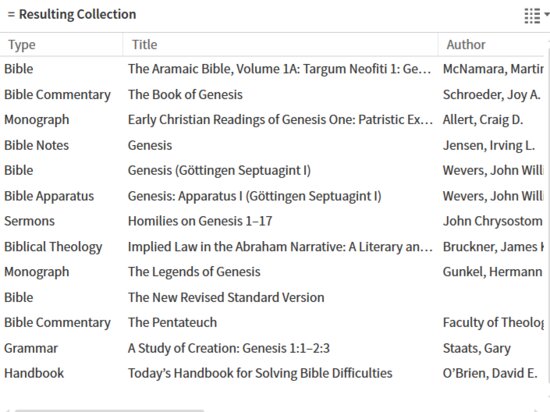
Genesis Demonstration Collection Bibliography
- Cathcart, Kevin, Michael Maher, and Martin McNamara, eds. The Aramaic BibleA: Targum Neofiti 1: Genesis. Translated by Martin McNamara. Vol. 1. Collegeville, MN: The Liturgical Press, 1992.
- Schroeder, Joy A., H. Lawrence Bond, Philip D. W. Krey, Ian Christopher Levy, and Thomas Ryan, eds. The Book of Genesis. Translated by Joy A. Schroeder. The Bible in Medieval Tradition. Grand Rapids, MI; Cambridge, U.K.: William B. Eerdmans Publishing Company, 2015.
- Allert, Craig D. Early Christian Readings of Genesis One: Patristic Exegesis and Literal Interpretation. BioLogos Books on Science and Christianity. Downers Grove, IL: IVP Academic: An Imprint of InterVarsity Press, 2018.
- Jensen, Irving L. Genesis. Do-It-Yourself Bible Studies. San Bernardino, CA: Here’s Life Publishers, Inc., 1990.
- Wevers, John William, ed. Genesis. Vol. I. Vetus Testamentum Graecum. Auctoritate Academiae Scientiarum Gottingensis Editum. Göttingen: Vandenhoeck & Ruprecht, 1974.
- Wevers, John William, ed. Genesis. Vol. I. Vetus Testamentum Graecum. Auctoritate Academiae Scientiarum Gottingensis Editum. Göttingen: Vandenhoeck & Ruprecht, 1974.
- John Chrysostom. Homilies on Genesis 1–17. Edited by Thomas P. Halton. Translated by Robert C. Hill. Vol. 74. The Fathers of the Church. Washington, DC: The Catholic University of America Press, 1986.
- Bruckner, James K. Implied Law in the Abraham Narrative: A Literary and Theological Analysis. Vol. 335. Journal for the Study of the Old Testament Supplement Series. London; New York: Sheffield Academic Press, 2001.
- Gunkel, Hermann. The Legends of Genesis. Translated by W. H. Carruth. Chicago: The Open Court Publishing Co., 1901.
- The Holy Bible: New Revised Standard Version. Nashville: Thomas Nelson Publishers, 1989.
- Gavigan, James, Brian McCarthy, and Thomas McGovern, eds. The Pentateuch. The Navarre Bible. Dublin; New York: Four Courts Press; Scepter Publishers, 1999.
- Staats, Gary. A Study of Creation: Genesis 1:1–2:3. Jesus Christ through Hebrew Grammar. Gary Staats, 2010.
- O’Brien, David E. Today’s Handbook for Solving Bible Difficulties. Minneapolis, MN: David E. O’Brien, 1990.
The titles that are underlined have only page number and/or author references; they are excluded from parallel resources. That is why The Legends of Genesis has an entry on our chosen pericope (Gen 11:27-32) but does not appear as a parallel resource.
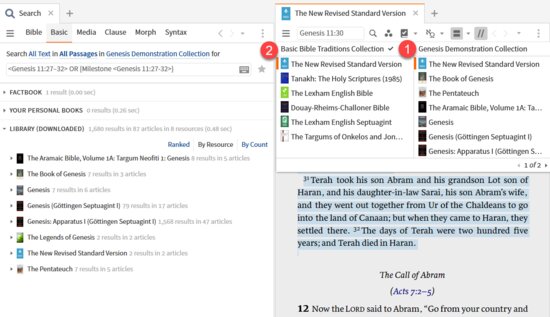
The Genesis Demonstration Collection (1) appears as parallel resources because:
- The collection is marked for “show in parallel resources”
- The open Bible (NRSV) is included in the collection
- The 7 resources (out of 13) that show as parallel resource have a shared reference (in this case Bible)
- The resource types differ: Bible, Bible Commentary, Bible Notes, Bible Apparatus
- One can access the parallel resources in any order by clicking the icon and selecting a title.
- After setting the parallel resources to one of the three available sets, one can access the parallel resources in sequence through keyboard shortcuts.
From Verbum Help:[quote]
• Ctrl+right arrow – Navigate to next parallel resource (use this if current resource has a horizontal scrollbar)
• Ctrl+left arrow – Navigate to previous parallel resource (use this if current resource has a horizontal scrollbar)[2]
• Right arrow – Navigate to next parallel resource
• Left arrow – Navigate to previous parallel resource[3]
Basic Bible Traditions Collection (2) is one of my primary collections – it also appears as parallel resources because:
- The collection consists only of Bible with a common Bible reference (Masoretic text, Septuagint text, Targums, Peshitta, Vulgate … )
- The collection includes in NRSV (in order to establish the broadest canon.
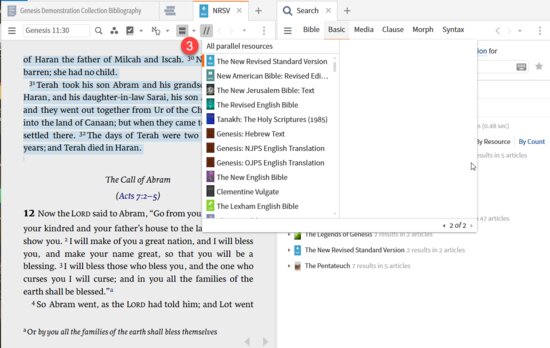
There is an additional default parallel set “all parallel resources” which includes all Bibles (and only Bibles) in priority sequence. This hints at some of the power of Verbum. Use for an example: John Chrysostom. Commentary on Saint John the Apostle and Evangelist: Homilies 1–47. Translated by Thomas Aquinas Goggin. Vol. 33. The Fathers of the Church. Washington, DC: The Catholic University of America Press, 1957.
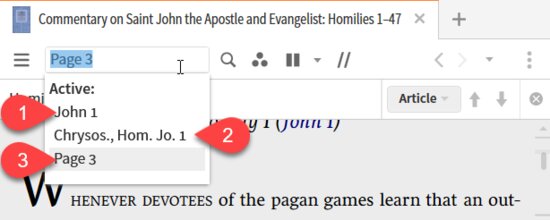
There are three choices for reference:
- A Bible reference which will produce many options for commentaries on the text on which the sermon is based. Why Bible commentaries not Bible texts? Because the resource in the resource panel is a Bible commentary.
- A John Chrysostom homily reference which will give texts and translations for the homily itself.
- Page number reference which provides no parallel resources.
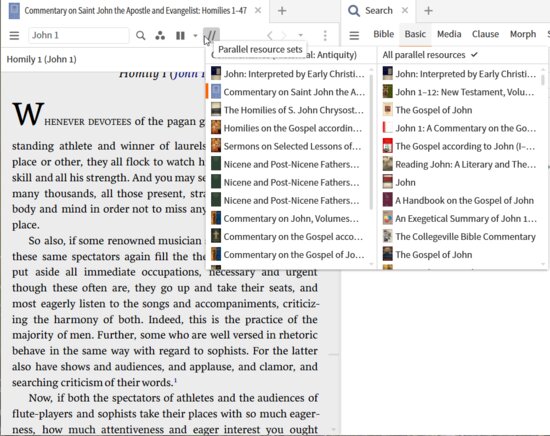
The Bible reference gives me two sets of parallel resources:
- Commentaries (Historical: Antiquity) – a collection shared by Mark Barnes
- The default All parallel resources
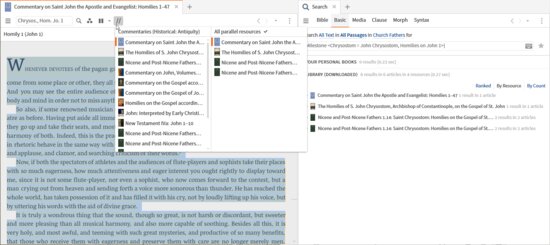
The Saint John Chrysostom reference also gives me two sets of parallel resources:
- Commentaries (Historical: Antiquity) – a collection shared by Mark Barnes
- The default All parallel resources
This time the All parallel resources matches a search on the Milestone for the reference i.e. all occurrences of the text of the homily in the library. The personal collection yields results based on reference rather than occurrence (milestone).
This also means that encyclicals in different languages are automatically linked and available to you via the arrow keys:

Up to five are also available in the Look up portion of the Context Menu:
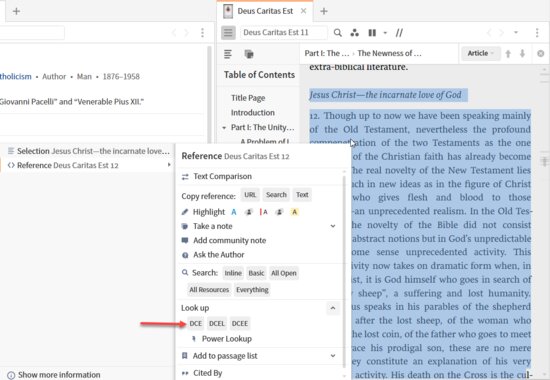
[1] Verbum Help (Bellingham, WA: Faithlife, 2018).
[2] Verbum Help (Bellingham, WA: Faithlife, 2018).
[3] Verbum Help (Bellingham, WA: Faithlife, 2018).